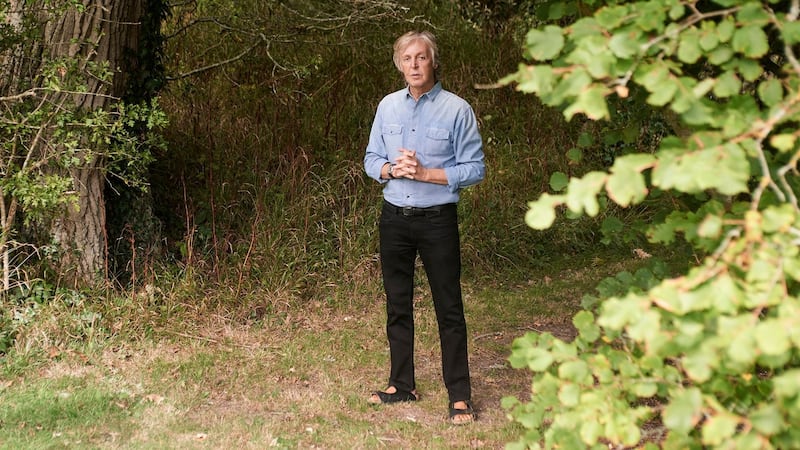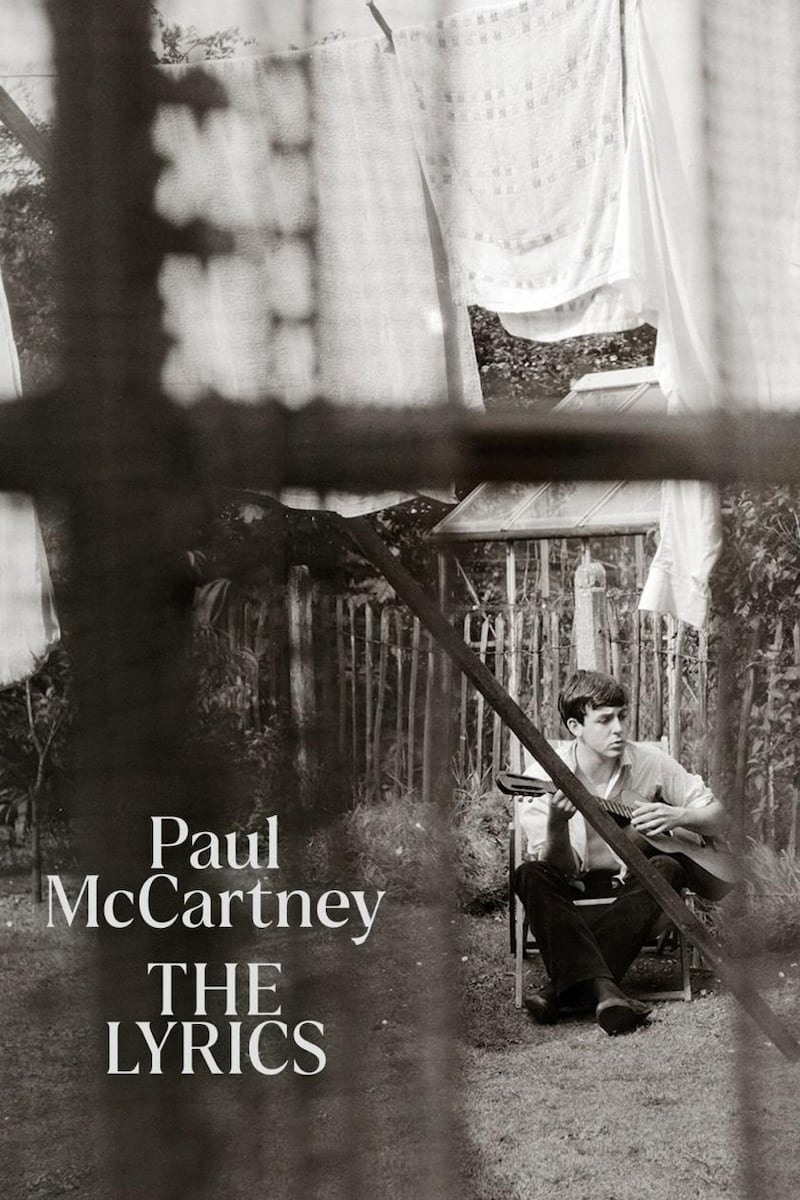Paul McCartney still has his house on Cavendish Avenue in St John’s Road, North London, a home he bought in 1965 at the height of Beatlemania. It’s around the corner from the famous studios at Abbey Road and the zebra crossing immortalised on the cover of the Beatles 11th album. For fans of McCartney and The Beatles, the area is a place of pilgrimage.
Last week 22-year-old Bailey Bienek, a McCartney superfan from Lincoln, brought his partner Amy there for a Beatles-themed stroll. It was a few hours before the former Beatle was due to speak to nearly 3,000 people at the Royal Festival Hall in the Southbank Centre to mark the release of his two-volume book The Lyrics: 1956 to the Present, written with Co Armagh poet Paul Muldoon. Bienek, wearing a denim jacket embroidered with McCartney’s name, was walking through the park around St John’s Wood church when he spotted a man with a familiar haircut up ahead.
“I recognised him by his hair from behind, I couldn’t believe it,” said the young man, recalling the moment he saw McCartney standing there.

A delighted Bienek recounted the story later as he waited to enter the hall where McCartney was about to speak. He said the former Beatle had noticed Bienek’s jacket. “Big fan, eh?” McCartney shook his hand and declined a selfie, saying: “This can be a private moment, just us.” They chatted for a few minutes. “He was kind and comical. He walked away saying see you tonight,” said Bienek, still not quite believing the encounter had happened.
There were others waiting for the event to begin who had similar stories, fans of several decades who have been following McCartney around for years. In the auditorium taking her seat, glamorous blonde-haired 71-year-old Sue Weisenhaus showed off the tattoo on her arm, an inked version of McCartney’s signature. “I’m an OG, an original groupie,” said Weisenhaus, who had travelled to London from her California home. “My husband left me 10 years ago because of my obsession – well, that was his excuse.”
Weisenhaus said she saw The Beatles play at the Hollywood Bowl in 1964. “This is the 118th time I’ve seen him. He gives me a magic I can’t find anywhere else. I’m a John girl who likes Paul. I keep John alive by following Paul.”
Wearing a T-shirt that read Fans on the Run, her fellow American and friend-in-McCartney Marianne Laffan (69) shared memories of seeing The Beatles at Shea Stadium at the age of 11. “I got carried off by the police for jumping on the field,” she said.
Unshaven
There were plenty more Macca stories and fervent fans in the room, but no more time to talk. At 7.30pm sharp, McCartney – trim, grey haired and unshaven – appeared at his first live event in two years to a rapturous reception. “Thank you,” the 79-year-old said simply as the audience rose to give the former Beatle a standing ovation.
I just remember how great it was to work with him. Because you are not just messing around, you are not singing with Joe Bloggs – you are singing with John Lennon
For 90 minutes, McCartney spoke with Muldoon about their collaboration on The Lyrics. The book, published by Penguin, explores the songwriter’s inspiration for 154 of his best-loved songs, beginning in childhood when he wrote his first song I Lost My Little Girl, and taking in The Beatles and Wings and his continuing solo career.In an amusing turn of events, broadcaster Samira Ahmed, who hosted the conversation, was the only person not called Paul on the stage. There was the main main Paul (McCartney), the poet Paul (Muldoon), and the two men named Paul who were providing sign language for the event. “Why have two Pauls when you can have four?” said Elaine Bedell, the Royal Festival Hall’s chief executive, introducing the event earlier. Welcoming McCartney, she said it had been a long road to getting the venue open again after 20 dark months. “You might say a long and winding road,” she told the audience who, on the night that was in it, cheered appreciatively.
It was a night for reminiscing and looking back at an extraordinary musical legacy. “The four of us miraculously found each other,” McCartney said of The Beatles in a wide-ranging conversation that touched on growing up in a loving, working-class, musical family in Liverpool in the 1950s, the death of his mother when he was 14 and the vast literary influences that informed his songwriting.
McCartney told a rapt audience about his personal and working relationship with songwriting partner John Lennon. “We grew up together,” he said. “It’s like walking up a staircase and we’ve always been side by side on that staircase. I’m like a fan. I just remember how great it was to work with him and how great he was. Because you are not just messing around, you are not singing with Joe Bloggs – you are singing with John Lennon.”
Love for Lennon
Sitting beside him on stage, Muldoon suggested to McCartney that what came across in their conversations, despite the occasional “wobble” in the relationship, was McCartney’s love for Lennon. “It’s very true,” said McCartney. “You say that I loved him and as 17-year-old Liverpool kids you could never say that. It just wasn’t done. So I never really said, ‘John, love you mate.’ I never got around to it so now it’s great to realise how much I love this man.”
At one point in the book McCartney discusses the Lennon song How Do You Sleep?, in which his former songwriting partner addressed him directly during their post-Beatles estrangement: “The only thing you done was yesterday/ And since you’ve gone you’re just another day.” Interestingly, the cutting barb is minimised in the book by McCartney as “one of his little pisstakes”.

It was clear Muldoon and the former Beatle, who were both wearing poppies, had developed an easy friendship over five years exploring McCartney’s lyrics from 1956 to the present. At one point McCartney, the son of Irish immigrants, gently teased Portadown-born Muldoon for always searching for an Irish angle on his life and work – even wondering whether McCartney took inspiration from Irish ballads in the “beyond compare” lyric from I Saw Her Standing There (he didn’t). McCartney’s maternal grandfather was Owen Mohan, who came from Tullynamalra in Co Monaghan.
“When we talked, I was always trying to give you a bit more Irish,” the man who once wrote a song called Give Ireland Back to the Irish told Muldoon. “My whole family is Irish, so there is a lot there, but I was hoping to throw you more bones.”
It was wonderful, said Muldoon, who edited the book, to "get under the skin of the lyrics" of songs over those conversations. He described the five-year process where he would meet McCartney for three-hour sessions to discuss his songs. "We were determined to come out of it with something fresh," said the Beatles fan who is 11 years younger than his subject, adding endearingly that he had to pinch himself at times during the process. "You pinched me," quipped McCartney.
Cousin Betty
Speaking of something fresh, even Beatles nerds might not have heard the story of McCartney and Lennon, sleeping top and tail in the bed in McCartney’s cousin Betty and her husband Mike’s house in Ryde, on the Isle of Wight. (Ryde was the inspiration for Ticket to Ride, the song they wrote there after hitchhiking to cousin Betty’s from Liverpool.) “Even though we were in our late teens, they’d come in at night and tuck us in,” recalled McCartney, fondly.
Liverpool Council filled in The Cavern – really like the Joni Mitchell song – to make a parking lot. So I'm quite happy that they're recognising that it's a tourist attraction
The audience was attentive and clearly ecstatic to be in a room with the songwriting legend. Celebrity fans in the audience included Stephen Fry, Simon Pegg and Caitlin Moran.There were never any controversial moments, although when asked what the biggest misconception was about being Paul McCartney, he answered “that I had broken The Beatles up . . . so I lived with that because once a headline is out there it sticks. That was a big one that I’ve only finally just got over.”
McCartney also gave an interesting response to Ahmed’s question about a proposed a new £2 million Beatles-themed tourist attraction for Liverpool, recently announced by the British government. Ahmed asked what he thought of it, suggesting that “some might say that there are people who might try and co-opt the Beatles into some kind of nationalistic, patriotic ideal of what it is to be British”.
“I don’t mind because I know that people from Japan, America, South America all know The Beatles. If they come to Liverpool, that’s a lot of what they come to see. I think it’s fine,” he said, recalling that “in the early days of our fame the Liverpool Council filled in The Cavern – really like the Joni Mitchell song – to make a parking lot. So I’m quite happy that they’re recognising that it’s a tourist attraction, but I think they could also spend the money on something else.”
As the event wrapped up and the audience stood for a second rousing ovation, 71-year-old OG Macca fan Sue Weisenhaus gave her assessment of the evening and of McCartney. “He’s at such a beautiful place right now, he’s growing his beard out, he’s at peace with his life. He’s got to be so fulfilled.”
The Lyrics: 1956 to the Present by Paul McCartney with Paul Muldoon is out now





















